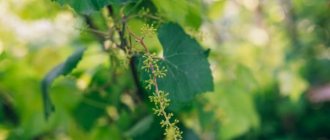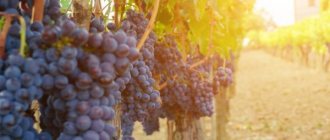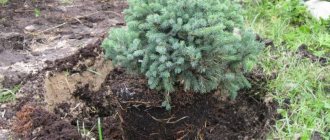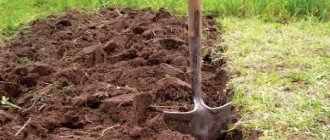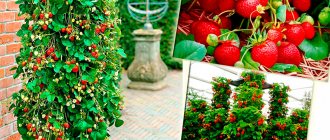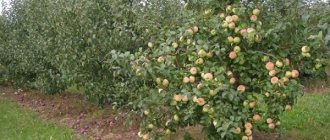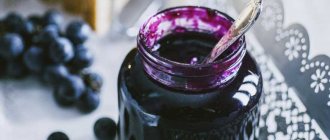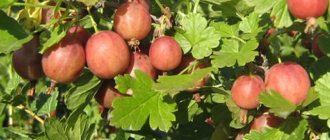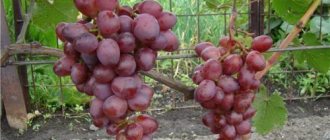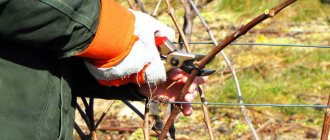Isabella grapes - what kind of variety it is, properties
Isabella is a grape variety that emerged as a result of natural selection. This occurred as a result of cross-pollination of the varieties Vitis Vinifera and Vitis Lambrusca.
Description and characteristics, what it looks like
Before planting Isabella grapes, they study the description of the crop. Bushes of this variety are characterized by rapid growth. They form thick vines with a large number of shoots. The berries form small clusters of cylindrical or conical shape. On average, they weigh about 200 g. The brushes have a loose or semi-loose structure.
Isabella is the result of natural selection
This crop can hardly be called large-fruited. The berries are round in shape and small in size. There are different types of fruits - white, dark blue, pink. The top of the berries are covered with a waxy coating. They contain many valuable microelements and bring great benefits to the body.
The fruit ripening period occurs in autumn. Many gardeners are interested in when to harvest grapes for wine. This is recommended to be done at the end of September or beginning of October.
Important! On average, it is possible to collect up to 10 kg of ripe fruits from one vine.
The grape bush is characterized by rapid development and has thick shoots
Advantages and disadvantages
Isabella grapes have many advantages:
- resistance to most fungal infections;
- resistance to high humidity;
- high productivity;
- pleasant taste;
- frost resistance down to -29 degrees;
- ease of care.
The disadvantages of culture include the following:
- drought intolerance;
- specific fruit aroma.
Scope of application
The culture belongs to the technical varieties. Its fruits can be consumed fresh. However, most often they are used for the production of juices and table wines. Many housewives use berries to make compote, jam, preserves.
In the eighties, in America and Europe, they decided to ban this variety of grapes for the production of wine drinks. This was motivated by the high content of methyl alcohol in the composition. However, today it has been established that the release of the substance is minimal and cannot cause harm to the body.
The grapes are technical varieties and are used to make wine
How to determine the ripeness of grapes
Determining the ripeness of grapes is not easy, since the process consists of several stages.
Among winegrowers, a distinction is made between the so-called technical and biological maturity of fruits:
- The technical stage occurs at the moment when the seeds in the berries finally ripen. At this time, the berries often do not manage to be completely filled with sugar, as well as the necessary aroma.
- Biological ripeness occurs when the concentration of sugars in the fruits sharply increases, the structure of the pulp and the color of the peel change.
Often the difference between technical and biological maturity is about 20 days. Thus, plants have developed a natural defense mechanism against fruit freezing. Even if the berry is not ripe, with technical ripeness the seeds can become active and produce a full-fledged sprout, which allows the bush to reproduce even under unfavorable conditions.
Grapes that have entered the phase of full biological ripeness are suitable for complete food processing. It is not easy to determine this indicator for Isabella; several observational indicators are used for this.
The first thing you should pay attention to is the speed of shoot growth; about a few weeks before ripening, the vine instantly stops growing. This process indicates that the plant actively accumulates sugar, nutrients and aromatic substances in the berries, which is why shoot growth is inhibited.
The onset of ripeness is also indicated by a change in the color of the berries. From a rich light green hue, it acquires a dark blue or purple color. However, often this characteristic is not enough to determine maturity.
After changing the shade of the berries, it is necessary to measure its sugar content. This is done using a special device - a hydrometer. The optimal fruit sugar content should be approximately 18%. If you don’t have such a device, you can identify the sugar content organoleptically; to do this, you need to taste 1-2 berries. When optimal aromatic properties are achieved, the crop is completely ready for harvest.
How to care for the Isabella variety
In order for the plant to develop normally and the crop to ripen on time, it is important to properly care for it.
Watering and fertilizing
This plant is considered moisture-loving. When grown in clay soil, the crop should be watered rarely but abundantly. Vines that grow in sandy soil need frequent and moderate watering.
The bush needs to be fed 3 times a year. The first time the procedure is carried out in the spring. At this stage, fertilizers containing nitrogen are used - ammonium sulfate or urea.
The second feeding is used when the fruits begin to appear and ripen. During this period, the culture needs potassium and phosphorus. Complex fertilizers are used for the last time. To ensure that the harvest can ripen, Florovit, Ecoplant and other products are used.
Reproduction of the variety, how and when to do it
It is recommended to propagate the culture by cuttings. To harvest planting material, it is worth cutting off part of the productive annual shoot. Its diameter should be 7-10 mm, and its length should be 1.5-2 m.
Then the vine can be cut into fragments measuring 20-40 cm. The upper cut should be located 2-3 cm above the eye. Then the cuttings should be soaked in a solution of iron sulfate for a couple of hours and stored in a cool place.
At the beginning of February, the planting material should be pulled out and placed in moistened pine sawdust. When roots appear, the bushes can be planted in a substrate of sand, soil and compost.
It is recommended to propagate grapes by cuttings
Description of the plant and specifics of cultivation
The vine is distinguished by its great growth vigor and well-ripening shoots. The perennial parts of the bush are covered with reddish, coarse-fibrous bark. The leaves are simple, large, round, mostly three-lobed or almost entire, smooth, dark green above, greenish-white below, with dense pubescence. The lateral notches are barely outlined or deep, obtuse, wide, with a rounded bottom. The petiole recess is open, vaulted, with a sharp bottom. The teeth at the ends of the blades are straight, triangular, with sharp tips. Along the edge - small or alternating with large ones. The petiole is equal in length to the midrib or shorter than it. The flowers are greenish, small (3-5 mm in diameter), bisexual. "Isabella" is fully pollinated by its own pollen even in bad weather and in the absence of insects. Gardeners note the absence of strong shedding of flowers and “peas” in the variety.
The bushes are characterized by powerful growth, especially on high arbors
Powerful growth and the ability to grow are used by gardeners who grow the vine as an ornamental plant on high arbors of various systems, when arranging alleys, for decorating fences, etc.
Fruitful shoots range from 65 to 85%, on average the load on each is 1.5 bunches (maximum 2.4). A distinctive feature of this grape is the good development of fruitful shoots from old wood and replacement buds, even in cases of freezing or damping off of the central buds, which guarantees the stability of the harvest. The most developed shoots are left for fruiting. It is recommended to trim fruit arrows short - by 2-4 buds, or medium - by 6-8.
For “Isabella”, it is recommended to leave approximately 25-30 healthy eyes per bush when cultivating according to the double-armed cordon type, which includes: planting according to a 2x1.5 m pattern, growing two mature strong shoots; creating a twisted trunk from them to the first tier of trellis wire at a height of 0.5-1 m; the formation of two horizontal shoulders of a cordon with fruit links, tying green growth to the wire of the second or third tier of the trellis, followed by free hanging.
Pest control and disease prevention
This plant is characterized by strong immunity. It practically does not suffer from fungal infections. The only exception is anthracnose. This pathology is accompanied by the appearance of spots on leaves and shoots. To avoid problems, you should use Bordeaux mixture or copper sulfate.
Isabella is practically not susceptible to massive pest invasions. This is due to the content of essential oils in the peel. Nitrofen can be used for preventive purposes.
When the berries reach ripeness, they may be damaged by birds. To protect the crop, a dense mesh with small cells is used. Thanks to this, the crop will be able to ripen, but will not be damaged by birds.
Isabella is a popular grape variety that has excellent taste. In order for it to ripen, the plant should be watered and fed on time. The harvested crop can be used to make wine, jam, jam, and juice.
Features of cultivation
In order for Isabella grapes to produce good harvests, you need to choose and organize the right place, as well as select high-quality seedlings.
For this grape variety you need:
- An area well sunny and ventilated.
- Soil with an average acidity level.
- If planted in autumn and under favorable conditions, you can get a harvest the following year.
- Removing weeds and loosening the soil.
- This variety is moisture-loving; you need to provide it with regular watering.
- Application of mineral fertilizers up to 3 times per season, organic fertilizers every 2-3 years.
Reference! If the growing conditions are met, the yield of an adult plant can be up to 50 kg per bush.
Trimming
To quickly form grapes on a high trunk, use the method of molding on stepsons. To do this, within 4 years you need to prune according to the following scheme by year:
Second
- In spring – pruning of annual shoots, leaving 2-3 eyes.
- Green shoots that have reached a length of 10-20 cm are cut off.
- Green shoots are removed again when they reach 40-50 cm in length.
- Each time you need to leave one, the most developed shoot.
- When the length of the shoot reaches a length 10 cm above the planned trunk, it is necessary to mint it (remove the tip of the shoot).
- After this, there should be 2 upper stepsons located opposite each other.
- When the shoots grow more than 30 cm, they need to be tied in different directions and pinched.
- When the stepchildren of the second level grow up, they need to be thinned out so that the distance between them is at least 20 cm.
Third
- Trim the stepchildren of the second level, leaving 3-4 eyes.
- After swelling, the buds are removed, leaving the top two.
- When the shoots from these buds grow, they need to be thinned out and tied up.
Fourth
- Trim the shoot that is closest to the ground, leaving 2 to 4 buds (replacement knots) on it.
- Form a fruit shoot from the top shoot, leaving up to 10 buds.
In the future, the bush requires annual maintenance and sanitary pruning.
Diseases and pests
“Isabella” is a disease and pest resistant variety. It tolerates frosty winters well. But with a lack of moisture, it can shed its leaves or produce a poorer harvest. You can learn about the sustainability system of grape varieties from a separate article.
Reference! Grape berries attract flocks of birds, which can eat a significant part of the harvest. To scare them away, stuffed animals or developing shiny ribbons are placed. If these methods do not help, you can put nylon tights on the bunches or completely cover the bush with a net.
“Isabella”, as a rule, is not in danger of being attacked by bees. It is quite difficult for insects to pierce the thick skin of these berries.
The most common insect pests, such as leaf rollers, felt and spider mites, are helped by various insecticides that can be purchased at garden stores.
And yet, prevention remains the best method of combating diseases. To prevent the entry and reproduction of insects, the vineyard is sprayed with Bordeaux mixture, a solution of copper or iron sulfate. To avoid infection with fungal diseases, treat the bushes with a solution of slaked lime.
Shelter for the winter
“Isabella” has good frost resistance. Thanks to this, it has become very popular among gardeners in Central Russia. The vine can withstand temperatures down to -30°C and does not require shelter for the winter. Even if the bush freezes slightly in the spring, new shoots will appear that can fully grow within a season.
Important! When growing this variety in the colder conditions of Siberia and the Urals, the vine should still be covered for the winter.
Harvest storage
The keeping quality of grapes is affected by various weather factors and storage conditions. Despite the fact that “Isabella” is a variety with a long shelf life, excess moisture can spoil the berries ahead of time. Therefore, the crop is harvested in dry weather, after several days have passed since the last rain.
These grapes can be stored for up to several months if hung by the bunch in a cool, dry place.
Regions
Gardeners throughout Russia fell in love with the unpretentious “Isabella”. Therefore, these grapes can be found in garden plots throughout the country - from Dagestan and the Krasnodar Territory, to the Moscow region, the Volga region and even Siberia.
But it is important to understand that this late variety may not have time to ripen if the northern regions had a very cool summer and the plant did not have enough sunny days.
